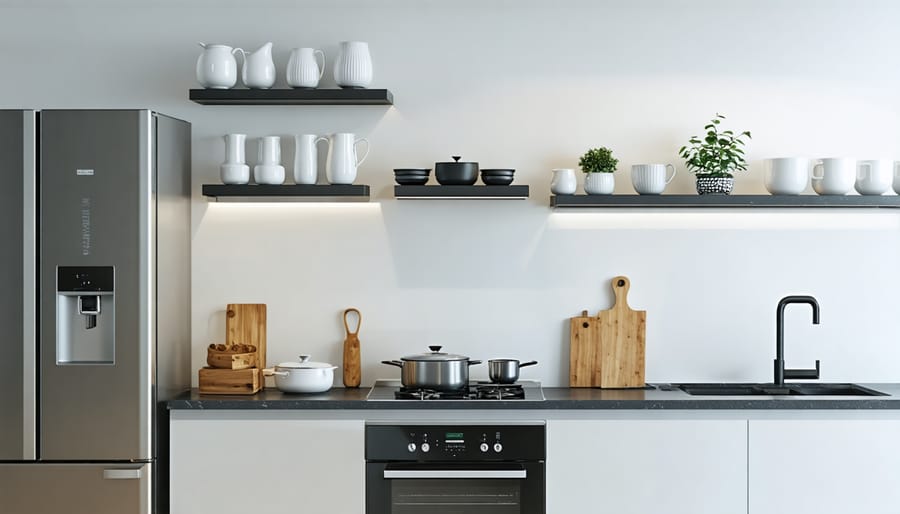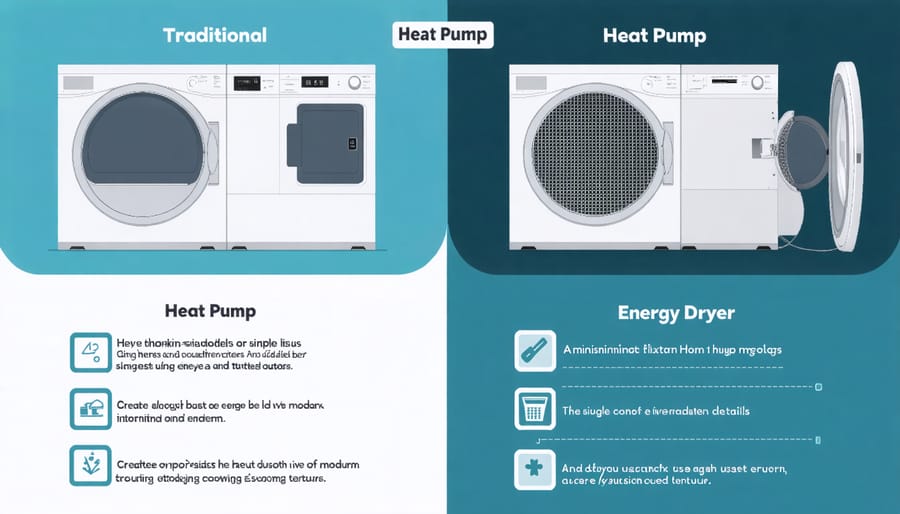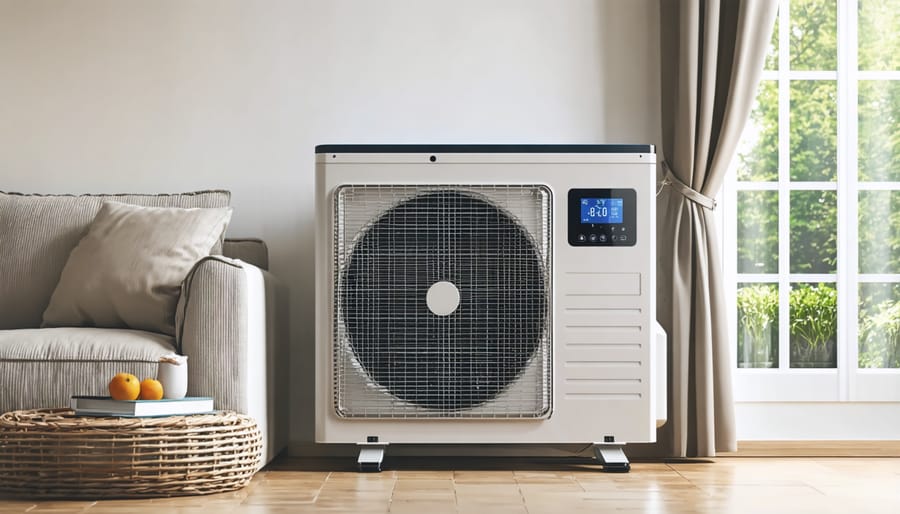Transform your home into an energy-saving powerhouse by upgrading to ENERGY STAR certified appliances that can reduce your energy bills by up to 50%. Modern energy-efficient refrigerators use less electricity than a 60-watt light bulb, while smart dishwashers save both water and power through precision sensors and improved washing technology. Heat pump dryers cut energy consumption by 50% compared to conventional models, and high-efficiency washing machines use 25% less electricity and 33% less water per load.
These innovations aren’t just about savings – they’re about smarter living. Advanced induction cooktops heat food faster while using 70% less energy than traditional electric ranges. Smart thermostats learn your schedule and automatically adjust temperatures, while LED lighting systems last 25 times longer than traditional bulbs while consuming 75% less power.
By choosing energy-efficient appliances, you’re not just investing in your home; you’re making a choice that benefits both your wallet and the environment. With federal tax credits and utility rebates available for many ENERGY STAR certified products, the initial investment often pays for itself within just a few years.

Kitchen Power-Savers: Essential Appliances for Modern Cooking
Refrigerators and Freezers
When it comes to energy efficiency in your home, your refrigerator and freezer are real workhorses that run 24/7. ENERGY STAR certified refrigerators use about 15% less energy than standard models, which can lead to significant savings over time.
Look for models with advanced features like dual cooling systems, which maintain optimal humidity levels in both the refrigerator and freezer compartments. These systems not only keep your food fresher longer but also reduce energy consumption by cooling each section independently.
Smart features to consider include door alarms that alert you when the door is left open, adjustable temperature controls, and LED lighting. These energy-efficient lights use less power and generate less heat than traditional bulbs, meaning your fridge doesn’t have to work as hard to stay cool.
Size matters too! A refrigerator that’s too large for your needs wastes energy, while one that’s too small might mean extra trips to the store. As a general rule, choose a model that provides 4-6 cubic feet of space per adult in your household.
The potential savings are impressive: switching to an ENERGY STAR certified refrigerator can save you up to $100 annually on energy bills and reduce your carbon footprint. Plus, many energy-efficient models qualify for local utility rebates, making the initial investment more affordable.
Pro tip: Keep your new refrigerator running efficiently by regularly cleaning the condenser coils and ensuring proper air circulation around the unit.
Dishwashers and Smart Water Usage
Modern dishwashers have come a long way in maximizing both water and energy efficiency. Today’s ENERGY STAR certified models use just 3.5 gallons of water per cycle, compared to the 20 gallons you’d use washing by hand. Look for models with soil sensors, which automatically adjust the wash cycle based on how dirty your dishes are.
To get the most out of your efficient dishwasher, skip pre-rinsing your dishes – just scrape off food debris. This simple change can save up to 20 gallons of water per load. Load your dishwasher strategically by placing larger items on the sides and back, and avoid blocking the spray arms.
Most energy-efficient dishwashers come with multiple cycle options. The eco-mode might take longer but uses less energy and water. Running your dishwasher during off-peak hours and using air-dry instead of heat-dry settings can further reduce energy consumption.
Pro tip: A full dishwasher uses the same amount of water as a half-full one, so wait until you have a complete load before running it. This habit maximizes efficiency and reduces your utility bills.
Cooking Appliances
When it comes to cooking appliances, energy efficiency can make a big difference in your utility bills. Modern ovens with convection features distribute heat more evenly and cook food faster, reducing energy consumption by up to 20%. Look for models with good insulation and self-cleaning features that use less energy than older versions.
Microwaves are inherently energy-efficient, using about 80% less energy than conventional ovens for reheating and cooking small portions. Choose models with automatic sensors that prevent overcooking and wasted energy by detecting when food is done.
Induction cooktops are the latest in energy-efficient cooking technology. They heat food directly through magnetic fields, losing less energy to the surrounding air compared to traditional electric or gas stovetops. While they require compatible cookware, induction cooktops can bring water to a boil in half the time of conventional methods.
Pro tip: Consider investing in a smart oven that connects to your phone. These models allow you to monitor cooking progress remotely and turn off the appliance if you accidentally left it running, saving both energy and peace of mind.
Laundry Room Efficiency Champions
Washing Machines
Modern energy-efficient washing machines combine innovative technology with smart design to help you save both water and electricity. Front-loading washers typically lead the pack in energy efficiency, using up to 50% less water and 30% less energy than traditional top-loaders. These savings come from their tumbling action, which requires less water while still delivering excellent cleaning performance.
Look for washers with the ENERGY STAR certification, which guarantees at least 25% better efficiency than standard models. Key features to watch for include high spin speeds (above 1,200 RPM), which extract more water during the spin cycle and reduce drying time. Many efficient models also offer cold water washing technologies that deliver great cleaning results without heating water.
Smart sensors play a crucial role in maximizing efficiency. These detect load size and soil levels, automatically adjusting water usage and wash time accordingly. Some advanced models even include load weight sensors that precisely measure how much water is needed for each cycle.
Water-saving technologies like automatic load sensing and precision dispensing ensure you use exactly the right amount of water and detergent. Many efficient washers also include features like delay start, which allows you to run loads during off-peak energy hours, and quick wash cycles for lightly soiled clothes.
Remember to choose the right size for your household needs – an oversized washer running partial loads wastes resources, while an undersized one requires more frequent washing.
Dryers
When it comes to energy-efficient drying solutions, heat pump dryers stand out as the most innovative and eco-friendly option available today. These advanced appliances use a heat pump system to recycle hot air, consuming up to 50% less energy than conventional dryers. While they may cost more upfront, the energy savings can offset the initial investment within a few years of regular use.
For those seeking more affordable alternatives, condensing dryers offer a middle-ground solution. These units don’t require external venting and are more energy-efficient than traditional vented dryers. They work by converting moisture into water, which is collected in a tank or drained directly.
To maximize efficiency with any dryer type, look for models with moisture sensors that automatically stop the cycle when clothes are dry. Features like eco modes and adjustable heat settings also help optimize energy usage. Many modern dryers now come with Energy Star certification, indicating they meet strict efficiency guidelines.
Smart dryer features can further reduce energy consumption. Some models connect to your smartphone, allowing you to monitor energy usage and receive notifications when your clothes are dry. This prevents unnecessary over-drying and helps extend the life of your garments while saving energy.
Pro tip: Regular maintenance, like cleaning the lint filter after each use and checking vent hoses annually, helps maintain optimal efficiency regardless of the dryer type you choose.

Smart HVAC and Water Heating Solutions

Heat Pumps and AC Units
Modern heat pumps and AC units represent a significant leap forward in home climate control efficiency. Today’s models offer impressive SEER (Seasonal Energy Efficiency Ratio) ratings of 18 or higher, making them substantially more efficient than older units that typically rate between 8-10 SEER.
Heat pumps are particularly noteworthy because they can both heat and cool your home. During winter, they extract heat from the outside air (even in cold temperatures) and move it indoors. In summer, they reverse the process, removing heat from your home. This dual functionality makes them an excellent choice for year-round comfort and energy savings.
When shopping for a new AC unit or heat pump, look for the ENERGY STAR® label and pay attention to these key features:
– Variable-speed motors that adjust output based on actual needs
– Smart thermostats compatibility for optimal temperature control
– Two-stage or multi-stage compression for better humidity control
– Thermal expansion valves for improved efficiency
The latest models can be integrated with smart home energy solutions, allowing you to control temperatures remotely and set automated schedules. This connectivity can lead to additional energy savings of 10-15% annually.
For maximum efficiency, consider these tips:
– Regular maintenance (clean filters monthly)
– Proper sizing for your space
– Professional installation
– Strategic thermostat placement
– Annual professional tune-ups
While efficient units may cost more upfront, they typically pay for themselves within 5-7 years through reduced energy bills and increased home comfort.
Water Heaters
When it comes to heating water efficiently, modern technology offers two outstanding options that can significantly reduce your energy consumption. Tankless water heaters, also known as on-demand water heaters, heat water only when you need it, eliminating the energy waste associated with keeping a large tank of water hot around the clock. These units can reduce your water heating costs by up to 30% compared to traditional tank models.
Solar water heaters take efficiency even further by harnessing free energy from the sun. These systems use solar collectors mounted on your roof to heat water, which is then stored in a well-insulated tank. While the initial investment is higher, solar water heaters can cut your water heating bills by 50-80%, making them an excellent long-term investment in sunny climates.
For maximum efficiency, consider these expert tips:
– Install your tankless water heater close to where you use hot water most frequently
– Ensure proper insulation of all hot water pipes
– Regular maintenance of solar collectors to maintain optimal performance
– Set your water temperature to 120°F (49°C) for the best balance of comfort and efficiency
Both options come with smart controls that let you monitor and adjust settings through your smartphone, helping you optimize energy usage. While tankless systems work well in any climate, solar water heaters are most effective in areas with abundant sunlight. For the best results, consider your local climate, household size, and hot water usage patterns when choosing between these energy-efficient alternatives.
Making the Smart Investment: Cost vs. Savings
While energy-efficient appliances often come with a higher price tag, they’re proving to be one of the smartest investments for modern homeowners looking to embrace eco-friendly home solutions. Let’s break down the numbers to see why the initial investment makes sense.
Consider a standard refrigerator priced at $800 versus an ENERGY STAR certified model at $1,000. While the energy-efficient version costs $200 more upfront, it typically saves $70-100 annually on electricity bills. This means you’ll recover the extra cost in just 2-3 years, with continued savings throughout the appliance’s 10-15 year lifespan.
The savings become even more attractive when you factor in available rebates and incentives. Many utility companies offer rebates ranging from $50-500 for energy-efficient appliances. Federal and state tax credits can also significantly reduce your initial investment. Be sure to check the Database of State Incentives for Renewables & Efficiency (DSIRE) website for current offers in your area.
Here’s a smart shopping tip: Look for the yellow EnergyGuide label on appliances. It shows the estimated yearly operating cost and energy consumption, making it easier to compare different models. While shopping, multiply the annual energy cost by the number of years you expect to keep the appliance – this gives you the lifetime operating cost to add to the purchase price.
Don’t forget about water savings too. Energy-efficient washing machines and dishwashers use 33% less water than conventional models, leading to lower water bills. A high-efficiency washing machine can save up to 7,000 gallons of water annually – that’s substantial savings on both your water and heating bills.
The key is to view energy-efficient appliances as long-term investments rather than expenses. When you factor in utility savings, rebates, and increased home value, the smart choice becomes clear.
Making the switch to energy-efficient appliances is a smart investment that pays off in multiple ways. Not only will you see significant reductions in your monthly utility bills, but you’ll also contribute to environmental conservation while enjoying modern, high-performing appliances. By following our home improvement tips and gradually upgrading your appliances, you can transform your home into an energy-efficient haven. Remember, even small changes like replacing old light bulbs or installing a programmable thermostat can make a meaningful difference. Start your energy-efficiency journey today by identifying which appliances in your home need upgrading first, and take advantage of available rebates and incentives to make the transition more affordable. Your wallet – and the planet – will thank you.
